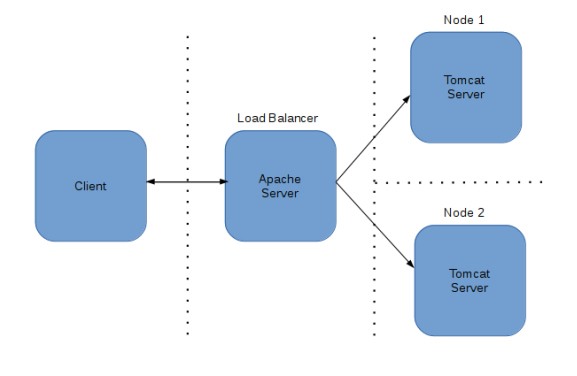Load Balancer with Apache
The following procedure demonstrates the way we can configure Apache Tomcat server to use load-balancing with the help of Apache server Mod Proxy OR JK_MOD plugin .
How it works?

Software
| Name | Link |
|---|---|
| JRE | Adopt Open JRE 8 |
| Apache Server | |
| Tomcat Server | |
| Apache MOD JK Plugin |
Setup Using Proxy Module
Configuring Tomcat Load Balancer with Apache web server using Mod Proxy is quite easy.
Step - 1: Edit httpd.conf file in the ${APACHE_SERVER_HOME}/conf folder to enable proxy_module, proxy_balancer_module and proxy_http_module modules.
LoadModule proxy_module modules/mod_proxy.so
LoadModule proxy_balancer_module modules/mod_proxy_balancer.so
LoadModule proxy_http_module modules/mod_proxy_http.so
Step - 2: Add proxy pass along with balancer name for application context root. In this example, I have a proxy path as TOMCAT_WEB_APPLICATION and balancer name as APACHE_BALANCER. Very important to include stickysession; as not having this option will have session expiry issues in an application. Edit httpd.conf file in the ${APACHE_SERVER_HOME}/conf folder.
<IfModule proxy_module>
ProxyRequests Off
ProxyPass /TOMCAT_WEB_APPLICATION balancer://APACHE_BALANCER stickysession=JSESSIONID
ProxyPassReverse /TOMCAT_WEB_APPLICATION balancer://APACHE_BALANCER stickysession=JSESSIONID
<Proxy balancer://APACHE_BALANCER>
BalancerMember http://TOMCAT_SERVER_HOST:HTTP_PORT/TOMCAT_WEB_APPLICATION route=server1
BalancerMember http://TOMCAT_SERVER_HOST:HTTP_PORT/TOMCAT_WEB_APPLICATION route=server2
</Proxy>
</IfModule>
Pros:
- No need for a separate module compilation and maintenance. mod_proxy, mod_proxy_http, mod_proxy_ajp and mod_proxy_balancer comes as part of standard Apache 2.2+ distribution
- Ability to use http https or AJP protocols, even within the same balancer.
Cons:
- mod_proxy_ajp does not support large 8K+ packet sizes.
- Basic load balancer
- Does not support Domain model clustering
Setup Using JK Module
A load balancer is a worker that does not directly communicate with Tomcat. Instead it is responsible for the management of several “real” workers, called members or sub workers of the load balancer.
Step - 1: Edit httpd.conf file in the ${APACHE_SERVER_HOME}/conf folder by adding the following line:
LoadModule jk_module modules/mod_jk.so
Step - 2: Create new file worker.properties in ${APACHE_SERVER_HOME}/conf folder.
worker.list=balancer,status
worker.tomcat1.type=AJP13
worker.tomcat1.port=AJP13_PORT_TOMCAT1
worker.tomcat1.host=TOMCAT_SERVER_HOST_TOMCAT1
worker.tomcat2.type=AJP13
worker.tomcat2.port=AJP13_PORT_TOMCAT2
worker.tomcat2.host=TOMCAT_SERVER_HOST_TOMCAT2
worker.balancer.type=lb
worker.balancer.balance_workers=tomcat1, tomcat2
worker.status.type=status
For more information about setting up the worker configuration file, see Apache Tomcat Connectors documentation.
Step - 3: Modify the httpd.conf file by adding load-balancer settings and pointing to the worker.properties file.
# Load balancer settings
JkWorkersFile ${APACHE_SERVER_HOME}/conf/worker.properties
JkShmFile ${APACHE_SERVER_HOME}/logs/mod_jk.shm
JkLogFile ${APACHE_SERVER_HOME}/logs/mod_jk.log
JkLogLevel error
JkMount /status status
JkMount /* balancer
JkOptions +ForwardURIProxy
JkOptions +ForwardURICompatUnparsed
Three options are available to ensure that the logs forwarded by HTTPD are left with the original Tomcat URL:
JkOptions +ForwardURIProxy The forwarded URI is partially reencoded after processing inside Apache and before forwarding to Tomcat. This option is compatible with local URL manipulation by mod_rewrite and with URL-encoded session IDs.
JkOptions +ForwardURICompatUnparsed The forwarded URI is unparsed, and is spec-compliant and secure. This option always forwards the original request URI, so rewriting URIs with mod_rewrite and then forwarding the rewritten URI does not work.
JkOptions ForwardURICompat The forwarded URI is decoded by Apache. Encoded characters are decoded and explicit path components such “..” are already resolved. This option is less spec-compliant and is not safe if you are using prefix JkMount. This option allows the rewriting of URIs with mod_rewrite before forwarding.
Step - 4: Set up AJP/1.3 connectors on the load-balanced Apache Tomcat servers. For each Tomcat server, edit the ${TOMCAT_HOME}/conf/server.xml file to add an AJP13 connector. Attribute ‘redirectPort’ should contain HTTP / HTTPs connector port.
<Connector port="port" protocol="AJP/1.3" redirectPort="8443"
maxThreads="150">
</Connector>
Note: If you have HTTPS set up, copy your HTTPS-enabled connector settings.
Pros:
- Advanced load balancer
- Advanced node failure detection
- Support for large AJP packet sizes
Cons:
- Need to build and maintain a separate module
### Blog Owner Information:
| Description | Github Profile Link | LinkedIn Profile Link | Email Address |
|---|---|---|---|
| Bhushan Patil | ravaan.techky@gmail.com |
documentation is maintained by ravaan-techky.